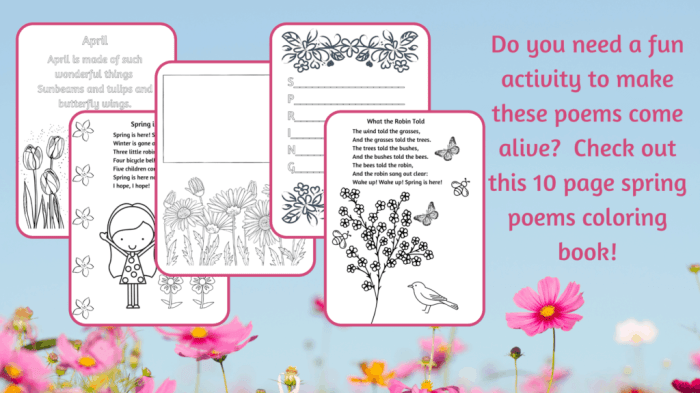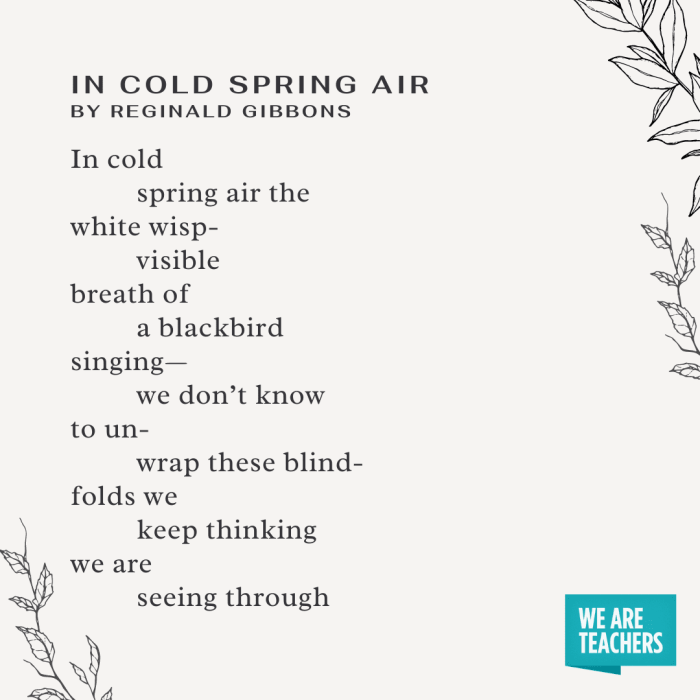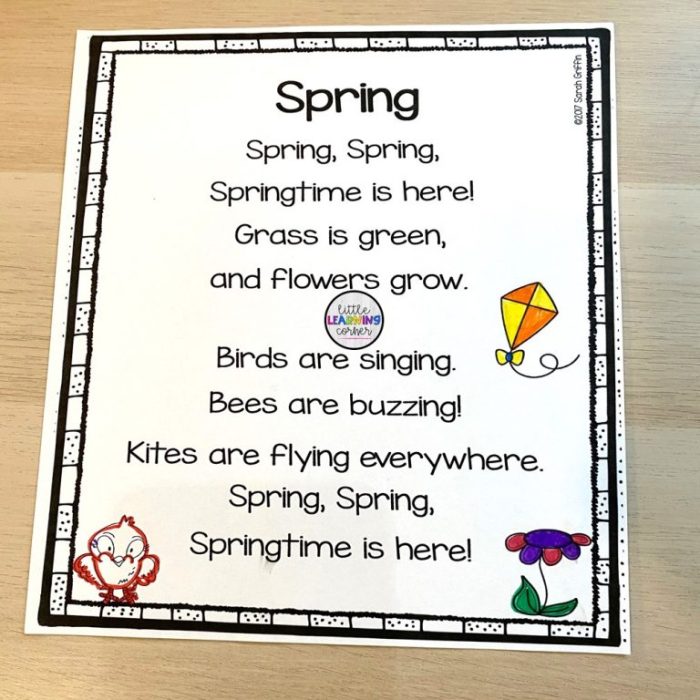Poemas de primavera cortos con rima, a literary genre that captures the essence of spring’s arrival, invites readers to immerse themselves in a world of vibrant imagery, sensory details, and poetic language. These concise verses celebrate the joy and renewal associated with the season, offering a glimpse into the awakening of nature, the beauty of flowers, and the symbolic meanings associated with this transformative time of year.
Through the use of metaphors, similes, personification, and vivid descriptions, these poems create a harmonious and lively atmosphere, evoking the sights, sounds, and scents of spring. Poets explore themes of hope, rebirth, and transformation, employing rhyme and rhythm to enhance the musicality and impact of their words.
Spring’s Arrival: Poemas De Primavera Cortos Con Rima

Spring’s arrival is a symphony of nature, a vibrant awakening that transforms the world with its ethereal touch. As the icy grip of winter loosens, the earth begins to stir, heralding the season of renewal and rebirth.
The air, once cold and unforgiving, now carries the sweet scent of blooming flowers, carried by a gentle breeze that whispers through the trees. The sun, no longer a distant memory, casts its golden rays upon the land, warming the earth and inviting new life to emerge.
Nature’s Canvas
Spring paints the landscape with a kaleidoscope of colors. Vibrant greens unfurl from the trees, their branches adorned with delicate blossoms. The ground is carpeted in a tapestry of wildflowers, each bloom a masterpiece of nature’s artistry. From the delicate petals of daisies to the bold hues of tulips, the world is transformed into a living canvas.
Nature’s Symphony
As spring awakens, nature bursts into a vibrant symphony of sounds and movements. Animals, birds, and insects stir from their winter slumber, each contributing to the harmonious chorus of the season.
The gentle breeze whispers through budding leaves, creating a rustling rhythm that dances in the air. Birdsong fills the skies, a cacophony of melodies that heralds the arrival of new life. From the cheerful chirping of sparrows to the sweet trills of robins, each note weaves into the tapestry of nature’s orchestra.
The Humming Chorus
Insects join the symphony, their buzzing and fluttering adding a lively undercurrent to the soundscape. Bees hum industriously, their wings creating a gentle drone as they collect nectar from blooming flowers. Butterflies flutter gracefully, their delicate wings fluttering in the breeze, adding a touch of ethereal beauty to the scene.
Animal Antics
Animals, too, play their part in nature’s symphony. Squirrels chatter excitedly as they scamper through trees, their playful antics adding a touch of whimsy to the forest. Frogs croak in the wetlands, their chorus rising and falling like a rhythmic chant.
Rabbits hop merrily through fields, their soft paws creating a gentle pattering sound.
Floral Delights

Spring is a season of renewal and rebirth, and one of the most noticeable signs of this is the profusion of flowers that bloom. These flowers come in a wide variety of colors, shapes, and fragrances, and they add a touch of beauty and joy to the world around us.
Some of the most popular spring flowers include tulips, daffodils, and hyacinths. Tulips are known for their vibrant colors and come in a wide range of varieties, from the classic red tulip to the more unusual parrot tulip. Daffodils are another cheerful flower that is often associated with spring.
They have bright yellow petals and a trumpet-shaped center. Hyacinths are known for their sweet fragrance and come in a variety of colors, including blue, pink, and white.
Alliteration and Assonance
Poets often use alliteration and assonance to create a musical effect in their work. Alliteration is the repetition of consonant sounds, while assonance is the repetition of vowel sounds. These techniques can be used to create a sense of rhythm and flow in poetry.
For example, the following lines from William Wordsworth’s poem “Daffodils” use alliteration and assonance to create a sense of movement and joy:
I wandered lonely as a cloudThat floats on high o’er vales and hills,
The repetition of the “l” sound in “lonely” and “lonely” creates a sense of rhythm, while the repetition of the “o” sound in “lonely,” “o’er,” and “hills” creates a sense of flow.
Symbolism and Metaphors

Spring, a season of renewal and rebirth, has been a rich source of inspiration for poets throughout history. In poetry, spring often symbolizes hope, new beginnings, and transformation. Poets use metaphors and imagery to convey these themes, creating vivid and evocative descriptions of the season.
Metaphors of Hope and Renewal
Spring is often associated with hope and the promise of new life. Poets use metaphors of light and growth to convey this sense of optimism. For example, in William Wordsworth’s poem “Ode: Intimations of Immortality,” spring is described as a “season of calm weather” that brings “hope and renovation.”
The image of the “calm weather” suggests a sense of peace and tranquility, while the “hope and renovation” represent the potential for renewal and growth.
Imagery of Transformation
Spring is also a time of transformation, as the landscape changes from the barrenness of winter to the vibrant colors of new life. Poets use imagery of metamorphosis and rebirth to capture this sense of change. For example, in Emily Dickinson’s poem “Hope” is the thing with feathers,” spring is described as a time when “nature is a haunted house” and “the dead begin to walk.”
These images suggest that spring is a time when the old order is overturned and a new one is born.
Symbolism of Rebirth
Finally, spring is often seen as a symbol of rebirth. Poets use imagery of water and renewal to convey this sense of rebirth. For example, in T.S. Eliot’s poem “The Waste Land,” spring is described as a time when “the winter lightning” strikes and “the dead tree gives new blossoms.”
These images suggest that even in the darkest of times, there is always the potential for renewal and rebirth.
Theme and Structure
Short spring poems with rhyme often explore common themes related to nature, renewal, and hope. These poems capture the beauty and wonder of the season, celebrating the arrival of warmer weather, blooming flowers, and the awakening of life after winter’s slumber.
The structure of these poems varies, but they typically adhere to traditional poetic forms, such as sonnets, quatrains, or free verse. Rhyme schemes are often employed to create a sense of rhythm and musicality, with common patterns including ABAB, AABB, and ABCB.
Rhyme Scheme
Rhyme scheme is a pattern of rhyme that occurs at the ends of lines in a poem. In short spring poems, rhyme schemes are often used to create a sense of rhythm and musicality. Common rhyme schemes include:
- ABAB: In this scheme, the first and third lines rhyme, and the second and fourth lines rhyme.
- AABB: In this scheme, the first and second lines rhyme, and the third and fourth lines rhyme.
- ABCB: In this scheme, the first and third lines rhyme, and the second and fourth lines rhyme.
Meter
Meter is the pattern of stressed and unstressed syllables in a poem. In short spring poems, meter is often used to create a sense of rhythm and flow. Common meters include:
- Iambic pentameter: This meter consists of ten syllables per line, with alternating stressed and unstressed syllables.
- Trochaic octameter: This meter consists of eight syllables per line, with alternating stressed and unstressed syllables.
- Anapestic trimeter: This meter consists of three syllables per line, with two unstressed syllables followed by a stressed syllable.
Stanza Patterns
Stanza patterns are the way that lines are grouped together in a poem. In short spring poems, stanza patterns are often used to create a sense of structure and organization. Common stanza patterns include:
- Quatrains: Stanzas of four lines.
- Sonnets: Stanzas of fourteen lines, typically following a specific rhyme scheme and meter.
- Free verse: Stanzas of varying lengths and patterns, without a set rhyme scheme or meter.
Overall Impact
The combination of rhyme scheme, meter, and stanza patterns in short spring poems contributes to their overall impact. These elements create a sense of rhythm, musicality, and structure that enhances the reader’s experience of the poem. They also help to convey the poet’s emotions and ideas about the season of spring.
Cultural and Historical Context
Spring poetry holds immense cultural and historical significance, deeply intertwined with the human experience. Poets across eras and cultures have celebrated the arrival of spring, capturing its transformative power and the promise of renewal.
Ancient Origins, Poemas de primavera cortos con rima
In ancient Greece, poets like Sappho and Pindar wrote odes to spring, praising its beauty and fertility. The season was associated with the goddess Persephone’s return from the underworld, symbolizing rebirth and hope.
Medieval Europe
During the Middle Ages, spring was celebrated in courtly love poetry. Troubadours composed songs about the joys of springtime and the awakening of love. Nature became a metaphor for the blossoming of romantic desire.
Renaissance and Enlightenment
The Renaissance and Enlightenment witnessed a resurgence of interest in classical themes. Poets like William Shakespeare and John Milton wrote sonnets and epics that celebrated the beauty and transience of spring.
Romanticism
In the Romantic era, poets like William Wordsworth and Samuel Taylor Coleridge found inspiration in the transformative power of nature. They saw spring as a symbol of the imagination’s ability to renew and inspire.
Modern and Contemporary
Modern and contemporary poets continue to explore the themes of spring. Some, like Pablo Neruda, celebrate its beauty and abundance, while others, like Sylvia Plath, delve into its darker aspects, such as the inevitability of change.
Questions and Answers
What is the significance of rhyme in poemas de primavera cortos con rima?
Rhyme plays a crucial role in enhancing the musicality and rhythmic flow of these poems, creating a sense of harmony and unity. It also aids in memorization and recitation, making these verses more accessible and enjoyable to readers.
How do poets use metaphors and imagery in poemas de primavera cortos con rima?
Poets employ metaphors and imagery to create vivid and evocative descriptions of spring’s arrival and the associated natural phenomena. These literary devices allow readers to experience the sights, sounds, and scents of the season through the power of imagination.
What are some common themes explored in poemas de primavera cortos con rima?
Common themes in these poems include the joy and renewal associated with spring, the awakening of nature, the beauty and diversity of flowers, and the symbolic meanings associated with this time of year. Poets often explore themes of hope, rebirth, and transformation through their verses.